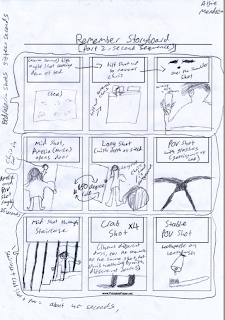The company behind the commercial are
government funded to raise awareness for road safety (The company is called
Think!). The commercial displays a series of shots of motorcyclists driving
through a city. All the motorcyclists have a bright display of lights attached
to their motorcycles with their names in neon lights displayed.
The significance of this is the company,
'Think!, are trying to relay to the audience the importance of being aware of
other drivers on the road and especially motorcyclists as they tend to weave in
and out of traffic more often.
The reason I'm analysing this commercial is
because like my short film, it starts with a jovial tone but ends with a
serious message. The difference being the commercial's message is on road
safety and mine is on cherishing memories. Two completely different things,
yet, similar in how they deliver the message.
The characters are of a reasonably low
significance in the commercial. But the small influence they have is important.
The commercial doesn't just pose them as strangers driving around. It puts
their names on neon lights attached to their motorcycles. This works to
personalise the characters more and therefore raise sympathy higher from the
audience if they were going to have a crash. It's showing that when someone is
killed they have a whole life around them that is lost, including friends,
co-workers and family. The photo below shows a driver with a light saying he's
just become a dad. This makes it more sentimental.

Since I live in the city, the setting of
the commercial helps me to relate it to my life. It also works to convey to
others that don't live in the city, that it is considered a more dangerous
place to drive than rural areas. Props and costumes entail the motorcyclists in
standard clothes of what everyday motorcyclists wear. Since it is a 'Think!'
commercial, overall, the costume and setting work almost immediately to convey
to the audience that is a road safety advert on being aware of other drivers,
especially ones on a motorcycle.
The background music throughout the advert
has a very jovial and light-hearted tone. In the past 'Think!' adverts have
been quite brutal and forceful showing violent sequences of crashes to get
their message across to the audience. However, here it retains its
light-hearted music throughout and instead of the message seeming like forceful
one, it comes across as something that should be easy to do and pay attention
to. A voiceover comes on at the end, stating 'Look out for Tom' and goes on to
list other names of the characters on the motorcycle. This again backs up the
sense of the company trying to tell the audience it's something easy to do and
people must simply exercise what the advert is saying. This is emphasised by
the colloquial tone the voiceover has.
The lighting is interesting in how it
creates the tone and atmosphere. The advert is shot in the night-time, allowing
the neon lights attached to the motorcycles to stand out very obviously against
the rest of the objects in the short film. The colourful lights contribute to
the jovial atmosphere made by the background music. What the main purpose of
the lights show is that they draw a huge amount of attention to the motorcycle
drivers, so normal drivers wouldn't even have to be aware of their surroundings
to notice them. Therefore what the message behind the lights point out is that
in every day life motorcycle drivers don't have vibrant neon lights to point
them out to other drivers, so drivers need to be aware of their surroundings,
especially when driving at night.

The camera techniques are also interesting
in how the commercial makers use them to point out the message of the road
safety. For example they do point of view shots. So the camera shot makes it
look as if we the audience are looking out from a car onto the road, with the
motorcyclist going by (shown below):
This camera shot is directly linked to the
message 'Think!' are trying to convey. It's putting the audience into a point of
view situation where they through the camera shot look out as if through their
car window on a passing motorcycle. This points out a simple/obvious other
point in road safety... Look before you turn!
Another point of view shot that I really
liked was when the camera shot, show the point of view to be looking at a
motorcycle behind the car through a side mirror:
This again is intelligent because it
presents the main message of the advert to look out for motorcyclists but again
presents another road safety point on checking you side mirrors. This is
especially relevant to motorcycles, as they tend to creep round the side of
cars.
The editing style is interesting in how
'Think!' are conveying their message. The advert starts with very short shots
of the motorcyclists going by, so the audience just view them as normal
motorcyclists and don't view them as anything special. However as the advert
progresses we see longer takes of the motorcyclists, allowing the audience to
read the words on the lights, telling us information about the drivers and
showing to the audience they are people like everyone else. They have family,
jobs and duties, etc. This works to make people more conscious of driving
safely.
The advert wouldn't really belong to a
particular genre. It serves the purpose of a safety advert in raising awareness
for the public.
Link to Trailer: http://www.youtube.com/watch?v=3-EDJj-gu2Q&safe=active






















